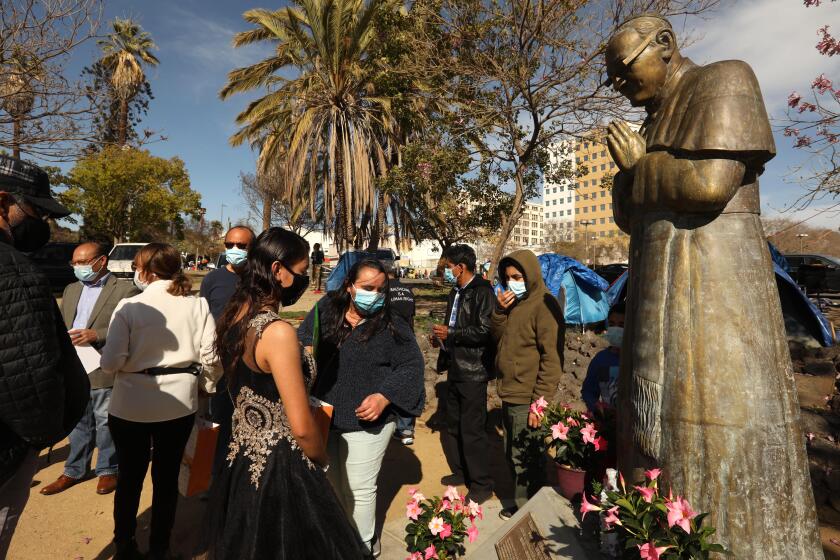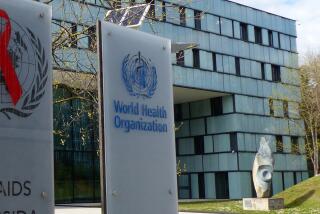Animals were likely source of coronavirus, not lab leak, WHO says

- Share via
BEIJING — A joint World Health Organization-China study on the origins of the coronavirus says transmission of the virus from bats to humans through another animal was the most likely scenario and that a lab leak was “extremely unlikely,” according to a draft copy obtained by the Associated Press.
The findings were largely as expected and left many questions unanswered, but the report provided in-depth detail on the reasoning behind the team’s conclusions. The team proposed further research in every area except the lab-leak hypothesis.
The report’s release has been repeatedly delayed, raising questions about whether the Chinese side was trying to skew the conclusions to prevent blame for the pandemic falling on China.
“We’ve got real concerns about the methodology and the process that went into that report, including the fact that the government in Beijing apparently helped to write it,” Secretary of State Antony Blinken said in a recent CNN interview.
China rejected that criticism Monday. “The U.S. has been speaking out on the report. By doing this, isn’t the U.S. trying to exert political pressure on the members of the WHO expert group?” Foreign Ministry spokesperson Zhao Lijian said.
The AP received what appeared to be a near-final version Monday from a Geneva-based diplomat from a WHO-member country. It wasn’t clear whether the report might be changed before its release. The diplomat did not want to be identified because they were not authorized to release it ahead of publication.
Even as vaccinations increase and COVID-19 cases low in California, officials urge caution during the spring holidays, including Easter and Passover.
The researchers listed four scenarios in order of likelihood. They concluded that transmission through a second animal was likely to very likely. They evaluated direct spread from bats to humans as likely and said spread through “cold-chain” food products was possible but not likely.
The closest relative of the virus that causes COVID-19 has been found in bats, which are known to carry coronaviruses. However, the report says that “the evolutionary distance between these bat viruses and SARS-CoV-2 is estimated to be several decades, suggesting a missing link.”
It said that highly similar viruses have been found in pangolins but also noted that mink and cats are susceptible to the virus, which suggests they could be carriers.
The report is based largely on a visit by a WHO team of international experts to Wuhan, the Chinese city where the coronavirus was first detected, from mid-January to mid-February.
The World Health Organization’s emergencies chief says it’s ‘premature’ and ‘unrealistic’ to think that the pandemic might be over by year’s end.
WHO Director-General Tedros Adhanom Ghebreyesus acknowledged that he had received the report over the weekend and said it would be formally presented Tuesday.
“We will read the report and discuss, digest its content and next steps with member states,” Tedros told a news conference Monday in Geneva. “But as I have said, all hypotheses are on the table and warrant complete and further studies from what I have seen so far.”
He declined to comment on whether political pressure had influenced the report.
The draft report is inconclusive on whether the outbreak started at a Wuhan seafood market that had one of the earliest clusters of cases in December 2019.
The discovery of other cases before the Huanan market outbreak suggests that it may have started elsewhere. But the report notes there could have been milder cases that went undetected and that could be a link between the market and earlier cases.
“No firm conclusion therefore about the role of the Huanan market in the origin of the outbreak, or how the infection was introduced into the market, can currently be drawn,” the report says.
As the pandemic spread globally, China found samples of the coronavirus on the packaging of frozen food coming into the country and, in some cases, have tracked localized outbreaks to them.
The report said that the cold chain, as it is known, can be a driver of long-distance virus spread but was skeptical that it could have triggered the outbreak. The report said the risk from such a source is lower than through human-to-human respiratory infection, and most experts agree.
“While there is some evidence for possible reintroduction of SARS-CoV-2 through handling of imported contaminated frozen products in China since the initial pandemic wave, this would be extraordinary in 2019 where the virus was not widely circulating,” the study said.
More to Read
Sign up for Essential California
The most important California stories and recommendations in your inbox every morning.
You may occasionally receive promotional content from the Los Angeles Times.












